Comprehensive Work Health and Safety Report for Webster Limited
VerifiedAdded on 2020/12/18
|14
|3792
|320
Report
AI Summary
This report provides a comprehensive analysis of Work Health and Safety (WHS) practices at Webster Limited, a food and beverage manufacturing company based in Tasmania. The report begins by identifying relevant WHS legislation, codes of practice, and the rights and responsibilities of employers and employees. It then delves into hazard identification, risk assessment, incident reporting, and the role of personal protective equipment (PPE). The report also explores how the organization monitors risks, consults with staff on WHS matters, and documents WHS activities. Furthermore, it examines processes that encourage staff contribution to WHS issues, WHS policies, and available training programs. The report concludes with a discussion of record-keeping policies, WHS priorities, and potential improvements. The report covers a range of topics, including WHS legislation, codes of practice, hazard identification, risk assessment, incident reporting, employee rights and responsibilities, WHS training programs, PPE, and record-keeping policies and procedures. The report also includes recommendations for improvements and ways to communicate these improvements effectively. The report is a valuable resource for understanding and improving WHS practices in the workplace.
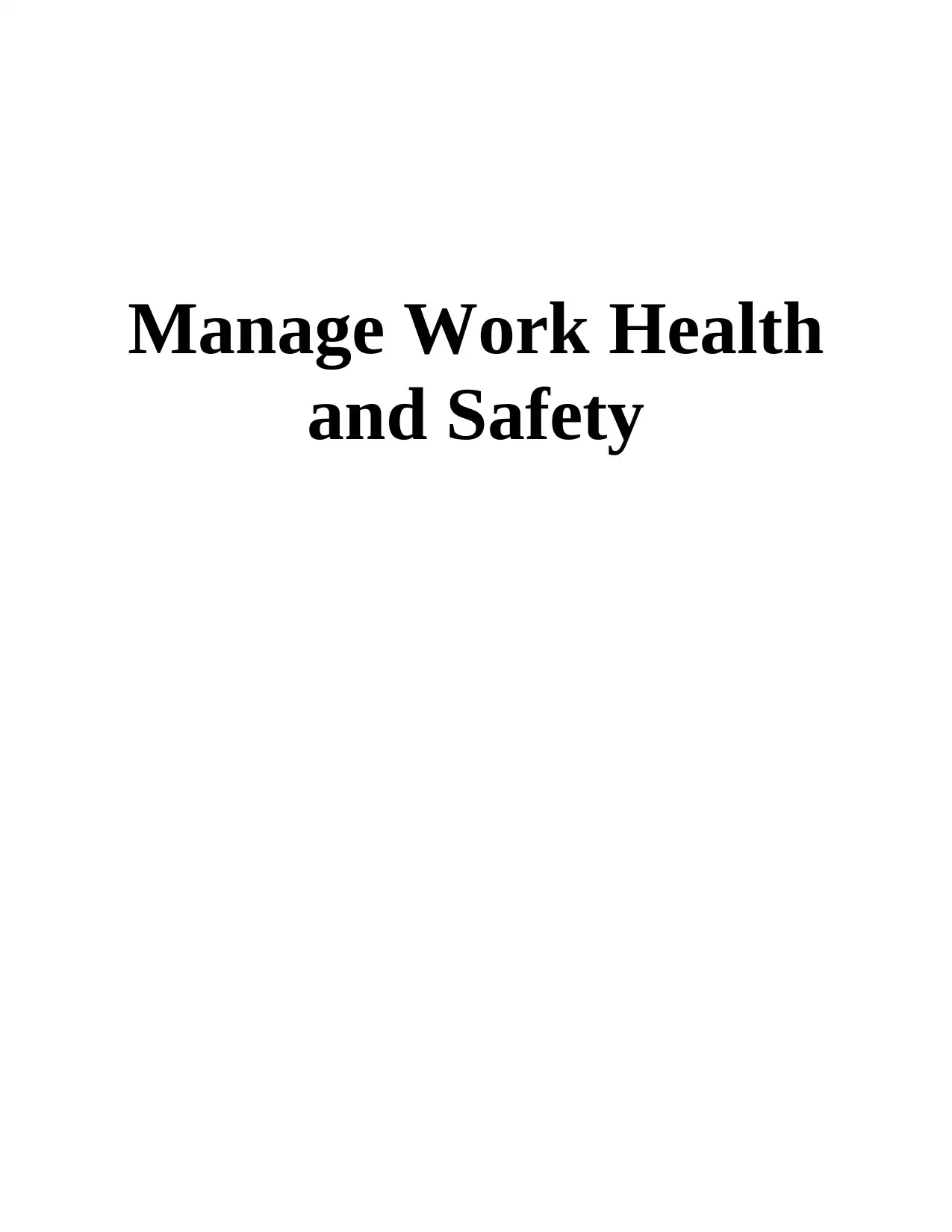
Manage Work Health
and Safety
and Safety
Paraphrase This Document
Need a fresh take? Get an instant paraphrase of this document with our AI Paraphraser
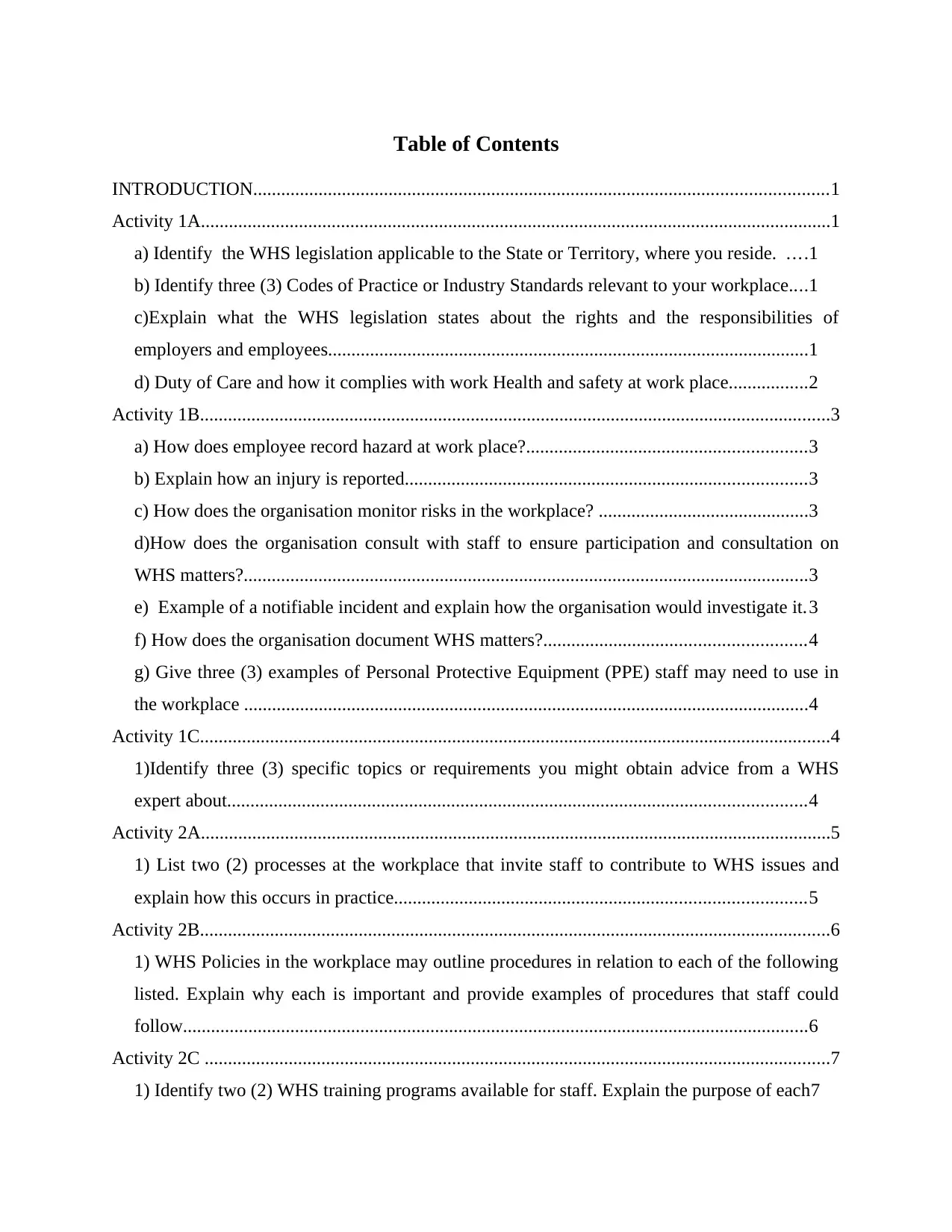
Table of Contents
INTRODUCTION...........................................................................................................................1
Activity 1A.......................................................................................................................................1
a) Identify the WHS legislation applicable to the State or Territory, where you reside. ....1
b) Identify three (3) Codes of Practice or Industry Standards relevant to your workplace....1
c)Explain what the WHS legislation states about the rights and the responsibilities of
employers and employees.......................................................................................................1
d) Duty of Care and how it complies with work Health and safety at work place.................2
Activity 1B.......................................................................................................................................3
a) How does employee record hazard at work place?............................................................3
b) Explain how an injury is reported......................................................................................3
c) How does the organisation monitor risks in the workplace? .............................................3
d)How does the organisation consult with staff to ensure participation and consultation on
WHS matters?.........................................................................................................................3
e) Example of a notifiable incident and explain how the organisation would investigate it.3
f) How does the organisation document WHS matters?........................................................4
g) Give three (3) examples of Personal Protective Equipment (PPE) staff may need to use in
the workplace .........................................................................................................................4
Activity 1C.......................................................................................................................................4
1)Identify three (3) specific topics or requirements you might obtain advice from a WHS
expert about............................................................................................................................4
Activity 2A.......................................................................................................................................5
1) List two (2) processes at the workplace that invite staff to contribute to WHS issues and
explain how this occurs in practice........................................................................................5
Activity 2B.......................................................................................................................................6
1) WHS Policies in the workplace may outline procedures in relation to each of the following
listed. Explain why each is important and provide examples of procedures that staff could
follow......................................................................................................................................6
Activity 2C ......................................................................................................................................7
1) Identify two (2) WHS training programs available for staff. Explain the purpose of each7
INTRODUCTION...........................................................................................................................1
Activity 1A.......................................................................................................................................1
a) Identify the WHS legislation applicable to the State or Territory, where you reside. ....1
b) Identify three (3) Codes of Practice or Industry Standards relevant to your workplace....1
c)Explain what the WHS legislation states about the rights and the responsibilities of
employers and employees.......................................................................................................1
d) Duty of Care and how it complies with work Health and safety at work place.................2
Activity 1B.......................................................................................................................................3
a) How does employee record hazard at work place?............................................................3
b) Explain how an injury is reported......................................................................................3
c) How does the organisation monitor risks in the workplace? .............................................3
d)How does the organisation consult with staff to ensure participation and consultation on
WHS matters?.........................................................................................................................3
e) Example of a notifiable incident and explain how the organisation would investigate it.3
f) How does the organisation document WHS matters?........................................................4
g) Give three (3) examples of Personal Protective Equipment (PPE) staff may need to use in
the workplace .........................................................................................................................4
Activity 1C.......................................................................................................................................4
1)Identify three (3) specific topics or requirements you might obtain advice from a WHS
expert about............................................................................................................................4
Activity 2A.......................................................................................................................................5
1) List two (2) processes at the workplace that invite staff to contribute to WHS issues and
explain how this occurs in practice........................................................................................5
Activity 2B.......................................................................................................................................6
1) WHS Policies in the workplace may outline procedures in relation to each of the following
listed. Explain why each is important and provide examples of procedures that staff could
follow......................................................................................................................................6
Activity 2C ......................................................................................................................................7
1) Identify two (2) WHS training programs available for staff. Explain the purpose of each7
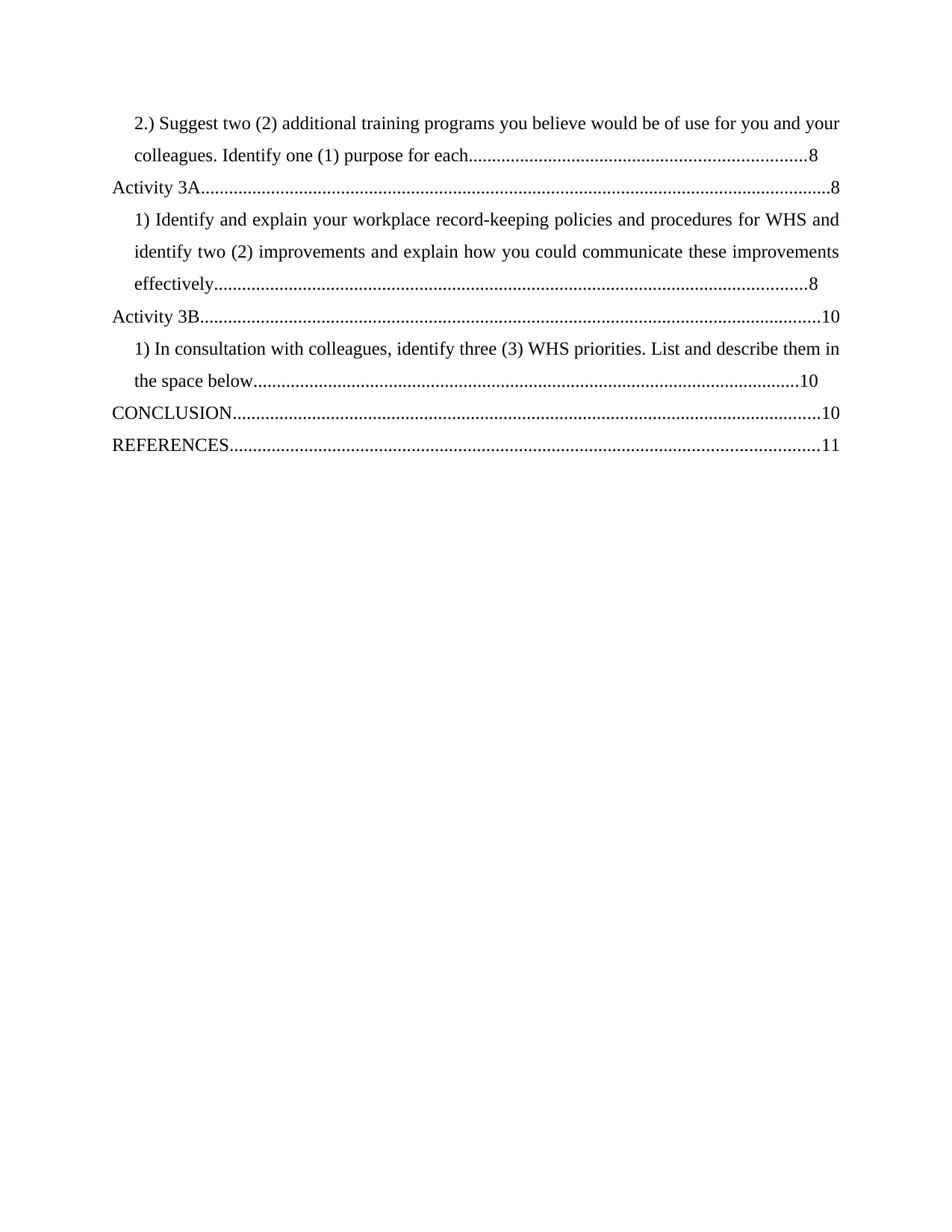
2.) Suggest two (2) additional training programs you believe would be of use for you and your
colleagues. Identify one (1) purpose for each........................................................................8
Activity 3A.......................................................................................................................................8
1) Identify and explain your workplace record-keeping policies and procedures for WHS and
identify two (2) improvements and explain how you could communicate these improvements
effectively...............................................................................................................................8
Activity 3B.....................................................................................................................................10
1) In consultation with colleagues, identify three (3) WHS priorities. List and describe them in
the space below.....................................................................................................................10
CONCLUSION..............................................................................................................................10
REFERENCES..............................................................................................................................11
colleagues. Identify one (1) purpose for each........................................................................8
Activity 3A.......................................................................................................................................8
1) Identify and explain your workplace record-keeping policies and procedures for WHS and
identify two (2) improvements and explain how you could communicate these improvements
effectively...............................................................................................................................8
Activity 3B.....................................................................................................................................10
1) In consultation with colleagues, identify three (3) WHS priorities. List and describe them in
the space below.....................................................................................................................10
CONCLUSION..............................................................................................................................10
REFERENCES..............................................................................................................................11
⊘ This is a preview!⊘
Do you want full access?
Subscribe today to unlock all pages.

Trusted by 1+ million students worldwide

Paraphrase This Document
Need a fresh take? Get an instant paraphrase of this document with our AI Paraphraser
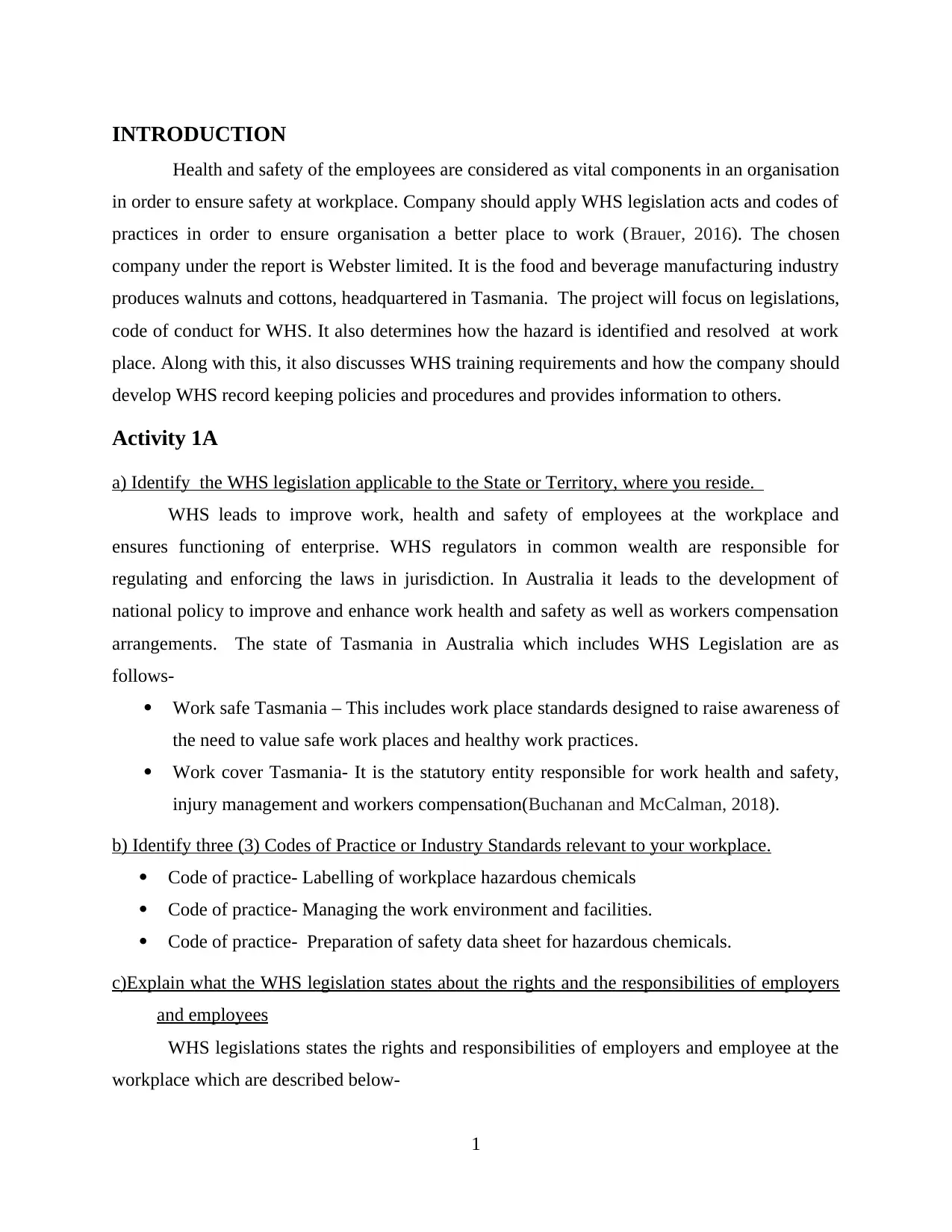
INTRODUCTION
Health and safety of the employees are considered as vital components in an organisation
in order to ensure safety at workplace. Company should apply WHS legislation acts and codes of
practices in order to ensure organisation a better place to work (Brauer, 2016). The chosen
company under the report is Webster limited. It is the food and beverage manufacturing industry
produces walnuts and cottons, headquartered in Tasmania. The project will focus on legislations,
code of conduct for WHS. It also determines how the hazard is identified and resolved at work
place. Along with this, it also discusses WHS training requirements and how the company should
develop WHS record keeping policies and procedures and provides information to others.
Activity 1A
a) Identify the WHS legislation applicable to the State or Territory, where you reside.
WHS leads to improve work, health and safety of employees at the workplace and
ensures functioning of enterprise. WHS regulators in common wealth are responsible for
regulating and enforcing the laws in jurisdiction. In Australia it leads to the development of
national policy to improve and enhance work health and safety as well as workers compensation
arrangements. The state of Tasmania in Australia which includes WHS Legislation are as
follows-
Work safe Tasmania – This includes work place standards designed to raise awareness of
the need to value safe work places and healthy work practices.
Work cover Tasmania- It is the statutory entity responsible for work health and safety,
injury management and workers compensation(Buchanan and McCalman, 2018).
b) Identify three (3) Codes of Practice or Industry Standards relevant to your workplace.
Code of practice- Labelling of workplace hazardous chemicals
Code of practice- Managing the work environment and facilities.
Code of practice- Preparation of safety data sheet for hazardous chemicals.
c)Explain what the WHS legislation states about the rights and the responsibilities of employers
and employees
WHS legislations states the rights and responsibilities of employers and employee at the
workplace which are described below-
1
Health and safety of the employees are considered as vital components in an organisation
in order to ensure safety at workplace. Company should apply WHS legislation acts and codes of
practices in order to ensure organisation a better place to work (Brauer, 2016). The chosen
company under the report is Webster limited. It is the food and beverage manufacturing industry
produces walnuts and cottons, headquartered in Tasmania. The project will focus on legislations,
code of conduct for WHS. It also determines how the hazard is identified and resolved at work
place. Along with this, it also discusses WHS training requirements and how the company should
develop WHS record keeping policies and procedures and provides information to others.
Activity 1A
a) Identify the WHS legislation applicable to the State or Territory, where you reside.
WHS leads to improve work, health and safety of employees at the workplace and
ensures functioning of enterprise. WHS regulators in common wealth are responsible for
regulating and enforcing the laws in jurisdiction. In Australia it leads to the development of
national policy to improve and enhance work health and safety as well as workers compensation
arrangements. The state of Tasmania in Australia which includes WHS Legislation are as
follows-
Work safe Tasmania – This includes work place standards designed to raise awareness of
the need to value safe work places and healthy work practices.
Work cover Tasmania- It is the statutory entity responsible for work health and safety,
injury management and workers compensation(Buchanan and McCalman, 2018).
b) Identify three (3) Codes of Practice or Industry Standards relevant to your workplace.
Code of practice- Labelling of workplace hazardous chemicals
Code of practice- Managing the work environment and facilities.
Code of practice- Preparation of safety data sheet for hazardous chemicals.
c)Explain what the WHS legislation states about the rights and the responsibilities of employers
and employees
WHS legislations states the rights and responsibilities of employers and employee at the
workplace which are described below-
1
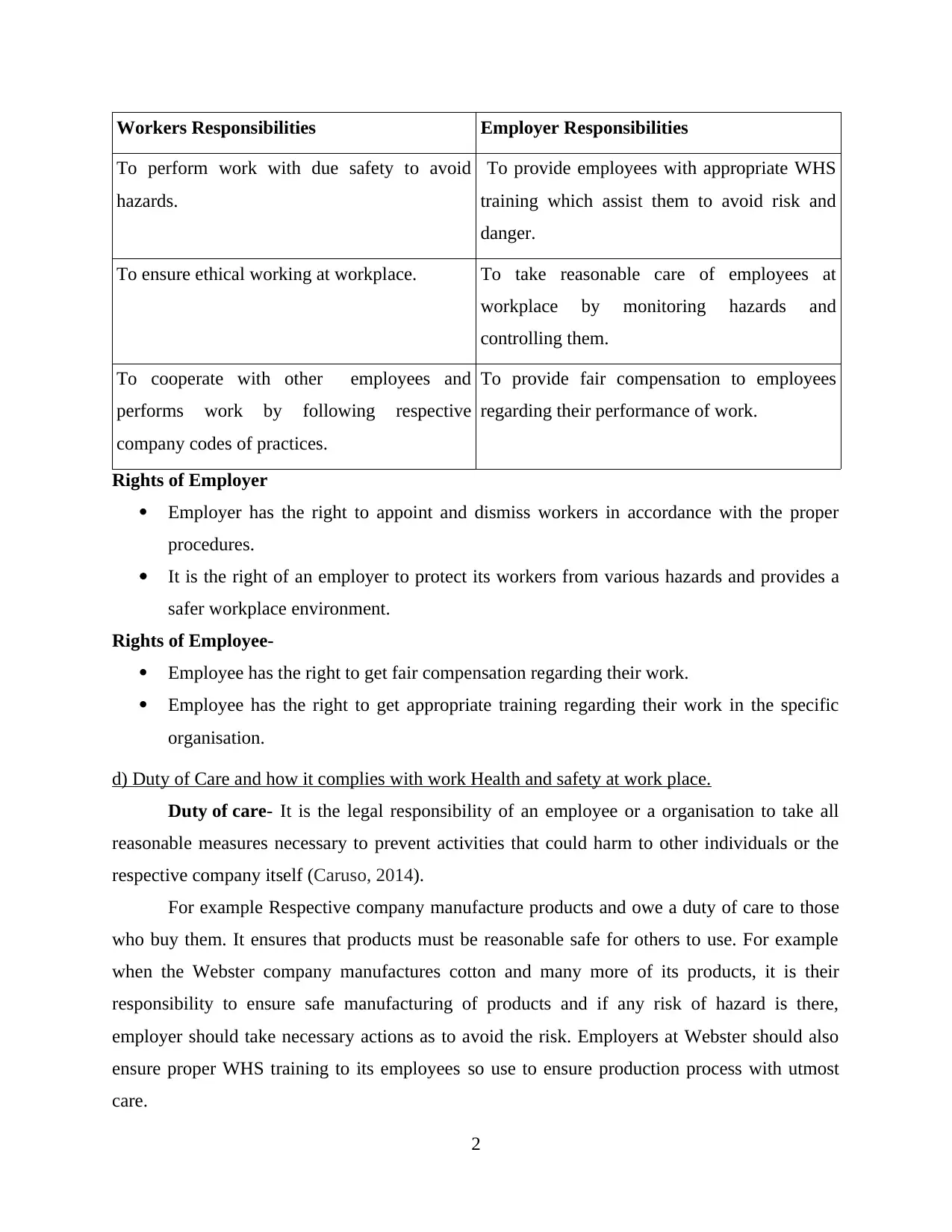
Workers Responsibilities Employer Responsibilities
To perform work with due safety to avoid
hazards.
To provide employees with appropriate WHS
training which assist them to avoid risk and
danger.
To ensure ethical working at workplace. To take reasonable care of employees at
workplace by monitoring hazards and
controlling them.
To cooperate with other employees and
performs work by following respective
company codes of practices.
To provide fair compensation to employees
regarding their performance of work.
Rights of Employer
Employer has the right to appoint and dismiss workers in accordance with the proper
procedures.
It is the right of an employer to protect its workers from various hazards and provides a
safer workplace environment.
Rights of Employee-
Employee has the right to get fair compensation regarding their work.
Employee has the right to get appropriate training regarding their work in the specific
organisation.
d) Duty of Care and how it complies with work Health and safety at work place.
Duty of care- It is the legal responsibility of an employee or a organisation to take all
reasonable measures necessary to prevent activities that could harm to other individuals or the
respective company itself (Caruso, 2014).
For example Respective company manufacture products and owe a duty of care to those
who buy them. It ensures that products must be reasonable safe for others to use. For example
when the Webster company manufactures cotton and many more of its products, it is their
responsibility to ensure safe manufacturing of products and if any risk of hazard is there,
employer should take necessary actions as to avoid the risk. Employers at Webster should also
ensure proper WHS training to its employees so use to ensure production process with utmost
care.
2
To perform work with due safety to avoid
hazards.
To provide employees with appropriate WHS
training which assist them to avoid risk and
danger.
To ensure ethical working at workplace. To take reasonable care of employees at
workplace by monitoring hazards and
controlling them.
To cooperate with other employees and
performs work by following respective
company codes of practices.
To provide fair compensation to employees
regarding their performance of work.
Rights of Employer
Employer has the right to appoint and dismiss workers in accordance with the proper
procedures.
It is the right of an employer to protect its workers from various hazards and provides a
safer workplace environment.
Rights of Employee-
Employee has the right to get fair compensation regarding their work.
Employee has the right to get appropriate training regarding their work in the specific
organisation.
d) Duty of Care and how it complies with work Health and safety at work place.
Duty of care- It is the legal responsibility of an employee or a organisation to take all
reasonable measures necessary to prevent activities that could harm to other individuals or the
respective company itself (Caruso, 2014).
For example Respective company manufacture products and owe a duty of care to those
who buy them. It ensures that products must be reasonable safe for others to use. For example
when the Webster company manufactures cotton and many more of its products, it is their
responsibility to ensure safe manufacturing of products and if any risk of hazard is there,
employer should take necessary actions as to avoid the risk. Employers at Webster should also
ensure proper WHS training to its employees so use to ensure production process with utmost
care.
2
⊘ This is a preview!⊘
Do you want full access?
Subscribe today to unlock all pages.

Trusted by 1+ million students worldwide
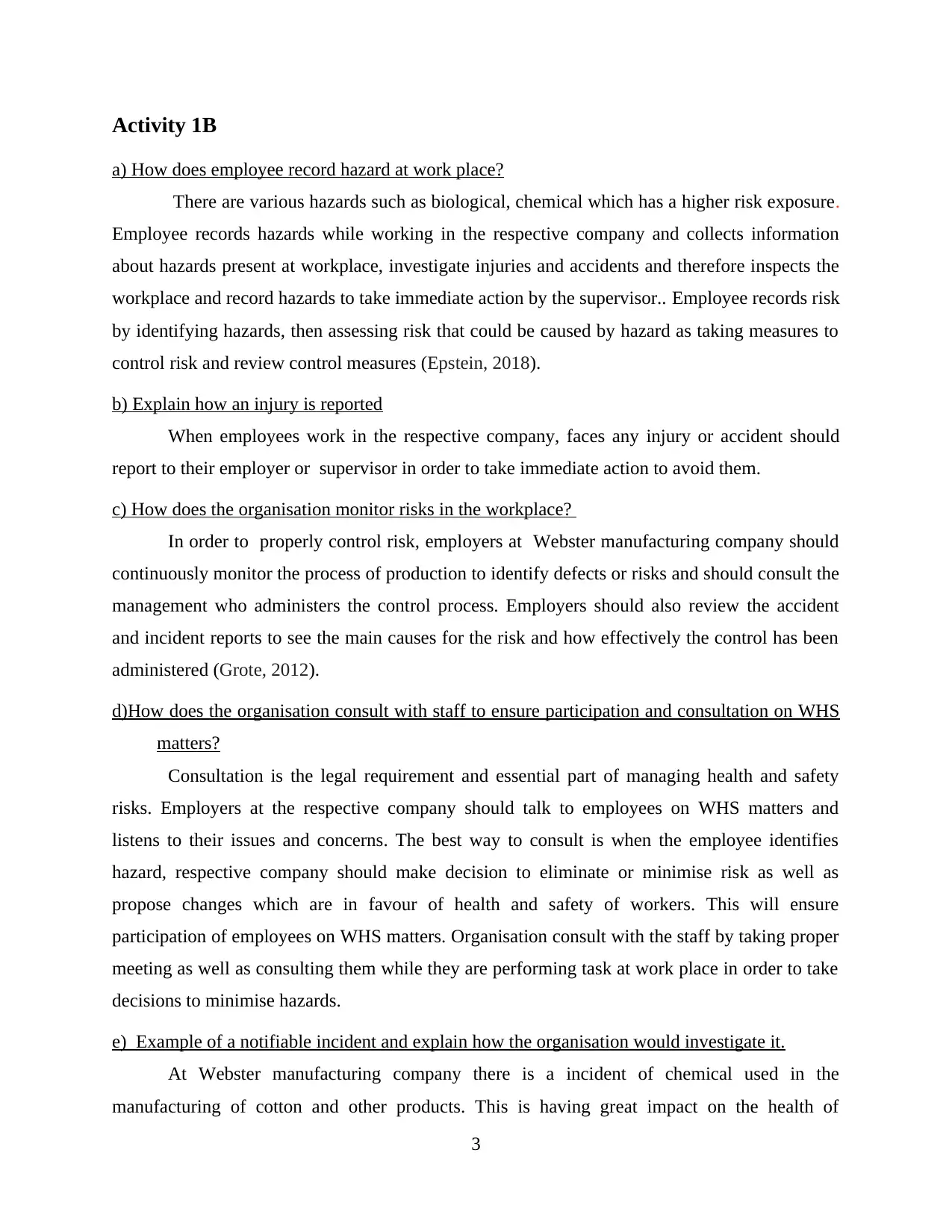
Activity 1B
a) How does employee record hazard at work place?
There are various hazards such as biological, chemical which has a higher risk exposure.
Employee records hazards while working in the respective company and collects information
about hazards present at workplace, investigate injuries and accidents and therefore inspects the
workplace and record hazards to take immediate action by the supervisor.. Employee records risk
by identifying hazards, then assessing risk that could be caused by hazard as taking measures to
control risk and review control measures (Epstein, 2018).
b) Explain how an injury is reported
When employees work in the respective company, faces any injury or accident should
report to their employer or supervisor in order to take immediate action to avoid them.
c) How does the organisation monitor risks in the workplace?
In order to properly control risk, employers at Webster manufacturing company should
continuously monitor the process of production to identify defects or risks and should consult the
management who administers the control process. Employers should also review the accident
and incident reports to see the main causes for the risk and how effectively the control has been
administered (Grote, 2012).
d)How does the organisation consult with staff to ensure participation and consultation on WHS
matters?
Consultation is the legal requirement and essential part of managing health and safety
risks. Employers at the respective company should talk to employees on WHS matters and
listens to their issues and concerns. The best way to consult is when the employee identifies
hazard, respective company should make decision to eliminate or minimise risk as well as
propose changes which are in favour of health and safety of workers. This will ensure
participation of employees on WHS matters. Organisation consult with the staff by taking proper
meeting as well as consulting them while they are performing task at work place in order to take
decisions to minimise hazards.
e) Example of a notifiable incident and explain how the organisation would investigate it.
At Webster manufacturing company there is a incident of chemical used in the
manufacturing of cotton and other products. This is having great impact on the health of
3
a) How does employee record hazard at work place?
There are various hazards such as biological, chemical which has a higher risk exposure.
Employee records hazards while working in the respective company and collects information
about hazards present at workplace, investigate injuries and accidents and therefore inspects the
workplace and record hazards to take immediate action by the supervisor.. Employee records risk
by identifying hazards, then assessing risk that could be caused by hazard as taking measures to
control risk and review control measures (Epstein, 2018).
b) Explain how an injury is reported
When employees work in the respective company, faces any injury or accident should
report to their employer or supervisor in order to take immediate action to avoid them.
c) How does the organisation monitor risks in the workplace?
In order to properly control risk, employers at Webster manufacturing company should
continuously monitor the process of production to identify defects or risks and should consult the
management who administers the control process. Employers should also review the accident
and incident reports to see the main causes for the risk and how effectively the control has been
administered (Grote, 2012).
d)How does the organisation consult with staff to ensure participation and consultation on WHS
matters?
Consultation is the legal requirement and essential part of managing health and safety
risks. Employers at the respective company should talk to employees on WHS matters and
listens to their issues and concerns. The best way to consult is when the employee identifies
hazard, respective company should make decision to eliminate or minimise risk as well as
propose changes which are in favour of health and safety of workers. This will ensure
participation of employees on WHS matters. Organisation consult with the staff by taking proper
meeting as well as consulting them while they are performing task at work place in order to take
decisions to minimise hazards.
e) Example of a notifiable incident and explain how the organisation would investigate it.
At Webster manufacturing company there is a incident of chemical used in the
manufacturing of cotton and other products. This is having great impact on the health of
3
Paraphrase This Document
Need a fresh take? Get an instant paraphrase of this document with our AI Paraphraser
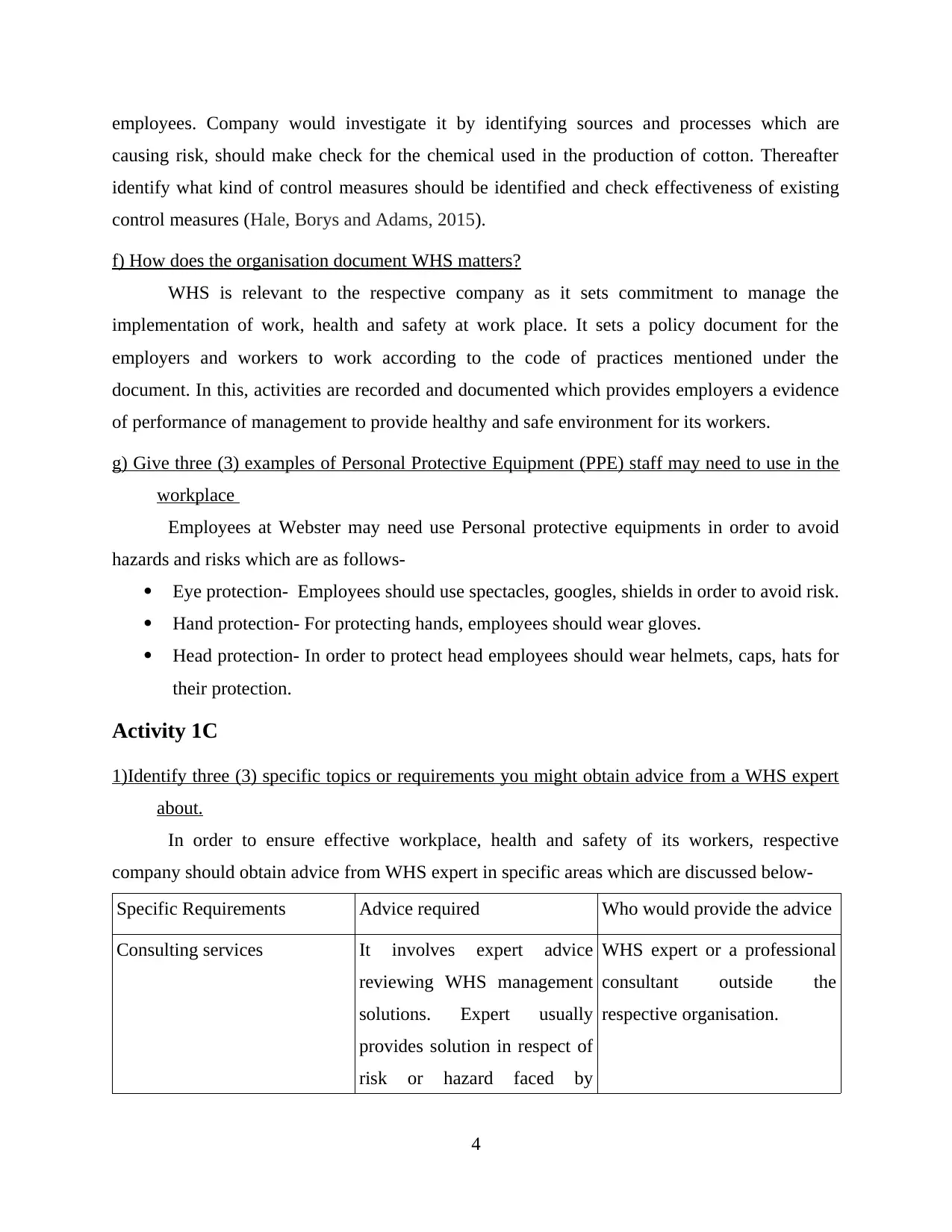
employees. Company would investigate it by identifying sources and processes which are
causing risk, should make check for the chemical used in the production of cotton. Thereafter
identify what kind of control measures should be identified and check effectiveness of existing
control measures (Hale, Borys and Adams, 2015).
f) How does the organisation document WHS matters?
WHS is relevant to the respective company as it sets commitment to manage the
implementation of work, health and safety at work place. It sets a policy document for the
employers and workers to work according to the code of practices mentioned under the
document. In this, activities are recorded and documented which provides employers a evidence
of performance of management to provide healthy and safe environment for its workers.
g) Give three (3) examples of Personal Protective Equipment (PPE) staff may need to use in the
workplace
Employees at Webster may need use Personal protective equipments in order to avoid
hazards and risks which are as follows-
Eye protection- Employees should use spectacles, googles, shields in order to avoid risk.
Hand protection- For protecting hands, employees should wear gloves.
Head protection- In order to protect head employees should wear helmets, caps, hats for
their protection.
Activity 1C
1)Identify three (3) specific topics or requirements you might obtain advice from a WHS expert
about.
In order to ensure effective workplace, health and safety of its workers, respective
company should obtain advice from WHS expert in specific areas which are discussed below-
Specific Requirements Advice required Who would provide the advice
Consulting services It involves expert advice
reviewing WHS management
solutions. Expert usually
provides solution in respect of
risk or hazard faced by
WHS expert or a professional
consultant outside the
respective organisation.
4
causing risk, should make check for the chemical used in the production of cotton. Thereafter
identify what kind of control measures should be identified and check effectiveness of existing
control measures (Hale, Borys and Adams, 2015).
f) How does the organisation document WHS matters?
WHS is relevant to the respective company as it sets commitment to manage the
implementation of work, health and safety at work place. It sets a policy document for the
employers and workers to work according to the code of practices mentioned under the
document. In this, activities are recorded and documented which provides employers a evidence
of performance of management to provide healthy and safe environment for its workers.
g) Give three (3) examples of Personal Protective Equipment (PPE) staff may need to use in the
workplace
Employees at Webster may need use Personal protective equipments in order to avoid
hazards and risks which are as follows-
Eye protection- Employees should use spectacles, googles, shields in order to avoid risk.
Hand protection- For protecting hands, employees should wear gloves.
Head protection- In order to protect head employees should wear helmets, caps, hats for
their protection.
Activity 1C
1)Identify three (3) specific topics or requirements you might obtain advice from a WHS expert
about.
In order to ensure effective workplace, health and safety of its workers, respective
company should obtain advice from WHS expert in specific areas which are discussed below-
Specific Requirements Advice required Who would provide the advice
Consulting services It involves expert advice
reviewing WHS management
solutions. Expert usually
provides solution in respect of
risk or hazard faced by
WHS expert or a professional
consultant outside the
respective organisation.
4
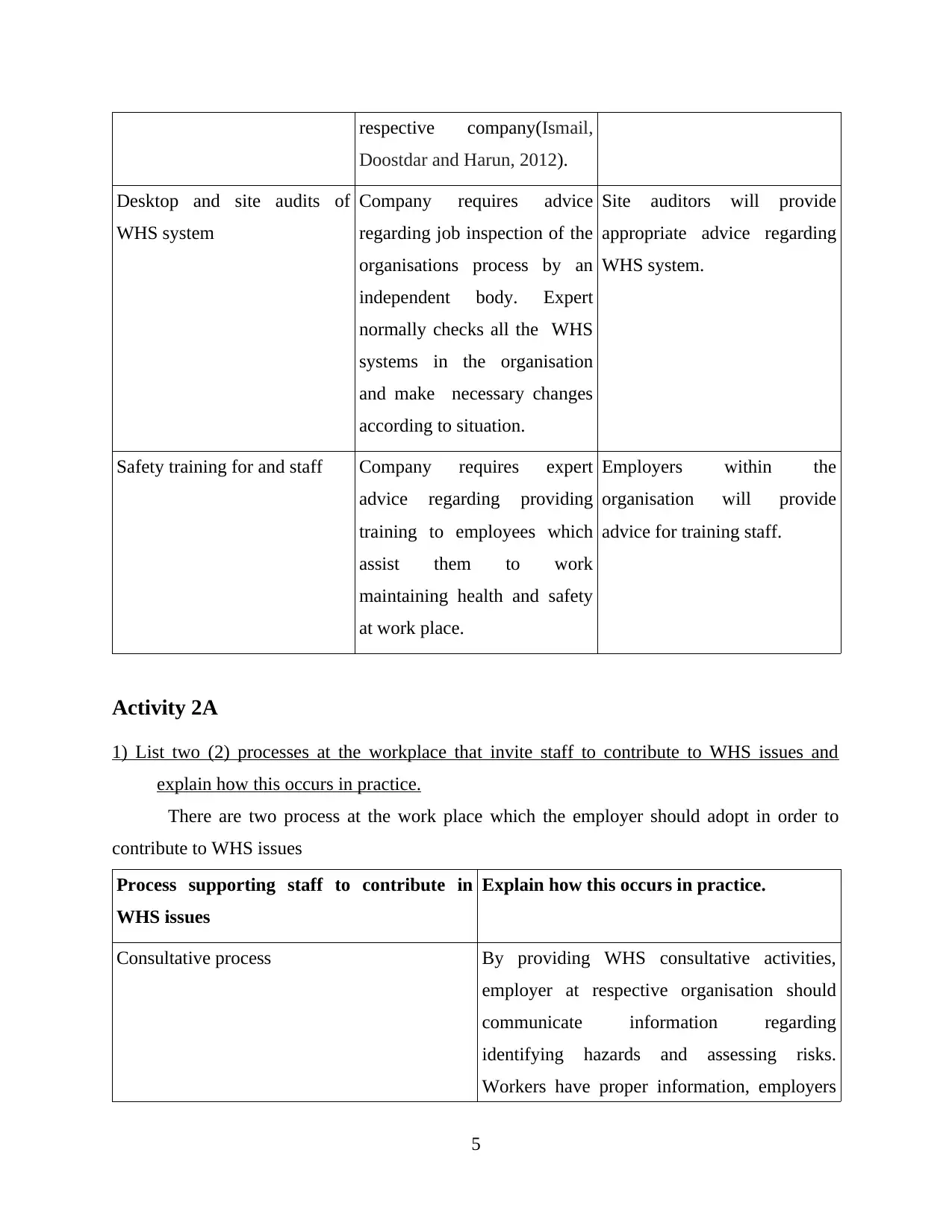
respective company(Ismail,
Doostdar and Harun, 2012).
Desktop and site audits of
WHS system
Company requires advice
regarding job inspection of the
organisations process by an
independent body. Expert
normally checks all the WHS
systems in the organisation
and make necessary changes
according to situation.
Site auditors will provide
appropriate advice regarding
WHS system.
Safety training for and staff Company requires expert
advice regarding providing
training to employees which
assist them to work
maintaining health and safety
at work place.
Employers within the
organisation will provide
advice for training staff.
Activity 2A
1) List two (2) processes at the workplace that invite staff to contribute to WHS issues and
explain how this occurs in practice.
There are two process at the work place which the employer should adopt in order to
contribute to WHS issues
Process supporting staff to contribute in
WHS issues
Explain how this occurs in practice.
Consultative process By providing WHS consultative activities,
employer at respective organisation should
communicate information regarding
identifying hazards and assessing risks.
Workers have proper information, employers
5
Doostdar and Harun, 2012).
Desktop and site audits of
WHS system
Company requires advice
regarding job inspection of the
organisations process by an
independent body. Expert
normally checks all the WHS
systems in the organisation
and make necessary changes
according to situation.
Site auditors will provide
appropriate advice regarding
WHS system.
Safety training for and staff Company requires expert
advice regarding providing
training to employees which
assist them to work
maintaining health and safety
at work place.
Employers within the
organisation will provide
advice for training staff.
Activity 2A
1) List two (2) processes at the workplace that invite staff to contribute to WHS issues and
explain how this occurs in practice.
There are two process at the work place which the employer should adopt in order to
contribute to WHS issues
Process supporting staff to contribute in
WHS issues
Explain how this occurs in practice.
Consultative process By providing WHS consultative activities,
employer at respective organisation should
communicate information regarding
identifying hazards and assessing risks.
Workers have proper information, employers
5
⊘ This is a preview!⊘
Do you want full access?
Subscribe today to unlock all pages.

Trusted by 1+ million students worldwide
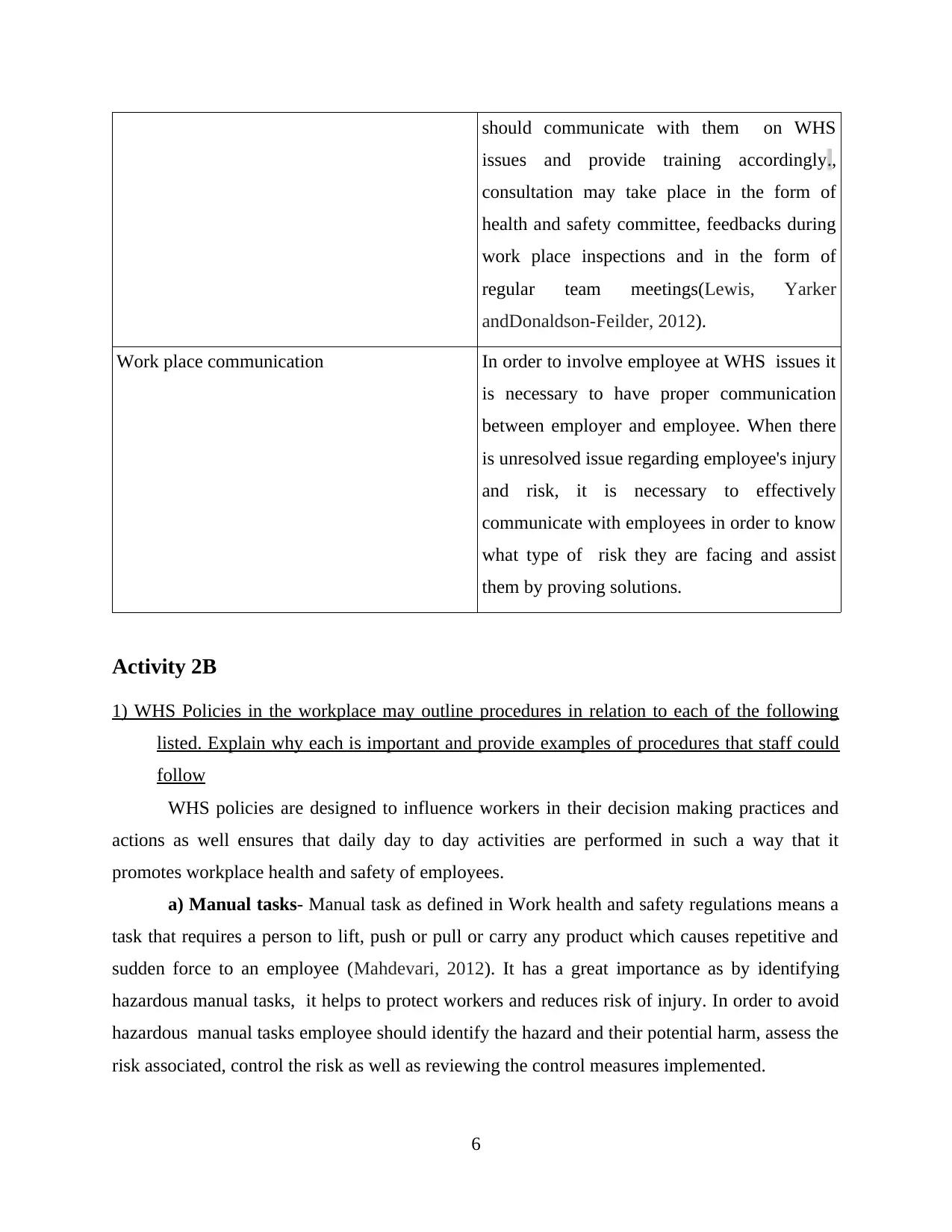
should communicate with them on WHS
issues and provide training accordingly.,
consultation may take place in the form of
health and safety committee, feedbacks during
work place inspections and in the form of
regular team meetings(Lewis, Yarker
andDonaldson-Feilder, 2012).
Work place communication In order to involve employee at WHS issues it
is necessary to have proper communication
between employer and employee. When there
is unresolved issue regarding employee's injury
and risk, it is necessary to effectively
communicate with employees in order to know
what type of risk they are facing and assist
them by proving solutions.
Activity 2B
1) WHS Policies in the workplace may outline procedures in relation to each of the following
listed. Explain why each is important and provide examples of procedures that staff could
follow
WHS policies are designed to influence workers in their decision making practices and
actions as well ensures that daily day to day activities are performed in such a way that it
promotes workplace health and safety of employees.
a) Manual tasks- Manual task as defined in Work health and safety regulations means a
task that requires a person to lift, push or pull or carry any product which causes repetitive and
sudden force to an employee (Mahdevari, 2012). It has a great importance as by identifying
hazardous manual tasks, it helps to protect workers and reduces risk of injury. In order to avoid
hazardous manual tasks employee should identify the hazard and their potential harm, assess the
risk associated, control the risk as well as reviewing the control measures implemented.
6
issues and provide training accordingly.,
consultation may take place in the form of
health and safety committee, feedbacks during
work place inspections and in the form of
regular team meetings(Lewis, Yarker
andDonaldson-Feilder, 2012).
Work place communication In order to involve employee at WHS issues it
is necessary to have proper communication
between employer and employee. When there
is unresolved issue regarding employee's injury
and risk, it is necessary to effectively
communicate with employees in order to know
what type of risk they are facing and assist
them by proving solutions.
Activity 2B
1) WHS Policies in the workplace may outline procedures in relation to each of the following
listed. Explain why each is important and provide examples of procedures that staff could
follow
WHS policies are designed to influence workers in their decision making practices and
actions as well ensures that daily day to day activities are performed in such a way that it
promotes workplace health and safety of employees.
a) Manual tasks- Manual task as defined in Work health and safety regulations means a
task that requires a person to lift, push or pull or carry any product which causes repetitive and
sudden force to an employee (Mahdevari, 2012). It has a great importance as by identifying
hazardous manual tasks, it helps to protect workers and reduces risk of injury. In order to avoid
hazardous manual tasks employee should identify the hazard and their potential harm, assess the
risk associated, control the risk as well as reviewing the control measures implemented.
6
Paraphrase This Document
Need a fresh take? Get an instant paraphrase of this document with our AI Paraphraser
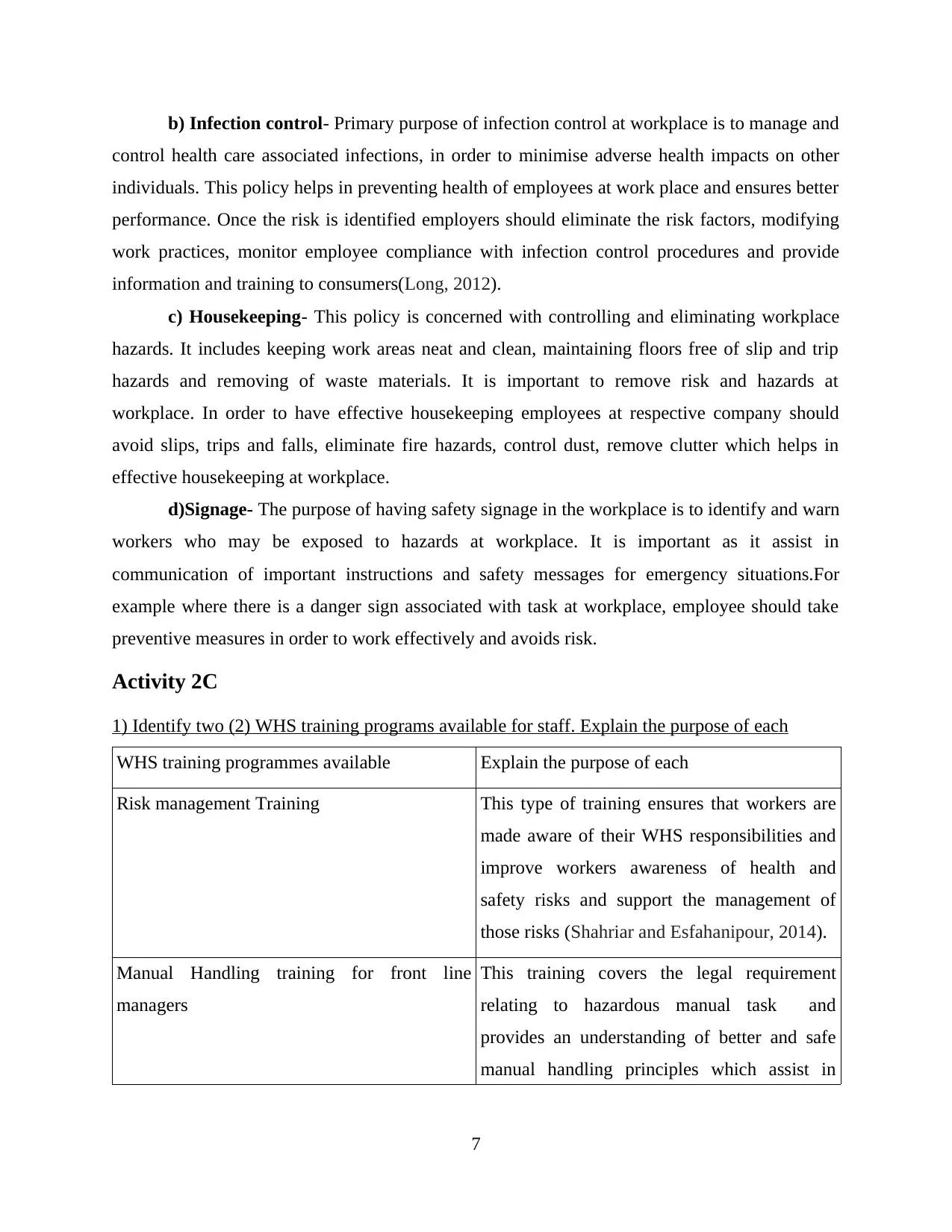
b) Infection control- Primary purpose of infection control at workplace is to manage and
control health care associated infections, in order to minimise adverse health impacts on other
individuals. This policy helps in preventing health of employees at work place and ensures better
performance. Once the risk is identified employers should eliminate the risk factors, modifying
work practices, monitor employee compliance with infection control procedures and provide
information and training to consumers(Long, 2012).
c) Housekeeping- This policy is concerned with controlling and eliminating workplace
hazards. It includes keeping work areas neat and clean, maintaining floors free of slip and trip
hazards and removing of waste materials. It is important to remove risk and hazards at
workplace. In order to have effective housekeeping employees at respective company should
avoid slips, trips and falls, eliminate fire hazards, control dust, remove clutter which helps in
effective housekeeping at workplace.
d)Signage- The purpose of having safety signage in the workplace is to identify and warn
workers who may be exposed to hazards at workplace. It is important as it assist in
communication of important instructions and safety messages for emergency situations.For
example where there is a danger sign associated with task at workplace, employee should take
preventive measures in order to work effectively and avoids risk.
Activity 2C
1) Identify two (2) WHS training programs available for staff. Explain the purpose of each
WHS training programmes available Explain the purpose of each
Risk management Training This type of training ensures that workers are
made aware of their WHS responsibilities and
improve workers awareness of health and
safety risks and support the management of
those risks (Shahriar and Esfahanipour, 2014).
Manual Handling training for front line
managers
This training covers the legal requirement
relating to hazardous manual task and
provides an understanding of better and safe
manual handling principles which assist in
7
control health care associated infections, in order to minimise adverse health impacts on other
individuals. This policy helps in preventing health of employees at work place and ensures better
performance. Once the risk is identified employers should eliminate the risk factors, modifying
work practices, monitor employee compliance with infection control procedures and provide
information and training to consumers(Long, 2012).
c) Housekeeping- This policy is concerned with controlling and eliminating workplace
hazards. It includes keeping work areas neat and clean, maintaining floors free of slip and trip
hazards and removing of waste materials. It is important to remove risk and hazards at
workplace. In order to have effective housekeeping employees at respective company should
avoid slips, trips and falls, eliminate fire hazards, control dust, remove clutter which helps in
effective housekeeping at workplace.
d)Signage- The purpose of having safety signage in the workplace is to identify and warn
workers who may be exposed to hazards at workplace. It is important as it assist in
communication of important instructions and safety messages for emergency situations.For
example where there is a danger sign associated with task at workplace, employee should take
preventive measures in order to work effectively and avoids risk.
Activity 2C
1) Identify two (2) WHS training programs available for staff. Explain the purpose of each
WHS training programmes available Explain the purpose of each
Risk management Training This type of training ensures that workers are
made aware of their WHS responsibilities and
improve workers awareness of health and
safety risks and support the management of
those risks (Shahriar and Esfahanipour, 2014).
Manual Handling training for front line
managers
This training covers the legal requirement
relating to hazardous manual task and
provides an understanding of better and safe
manual handling principles which assist in
7
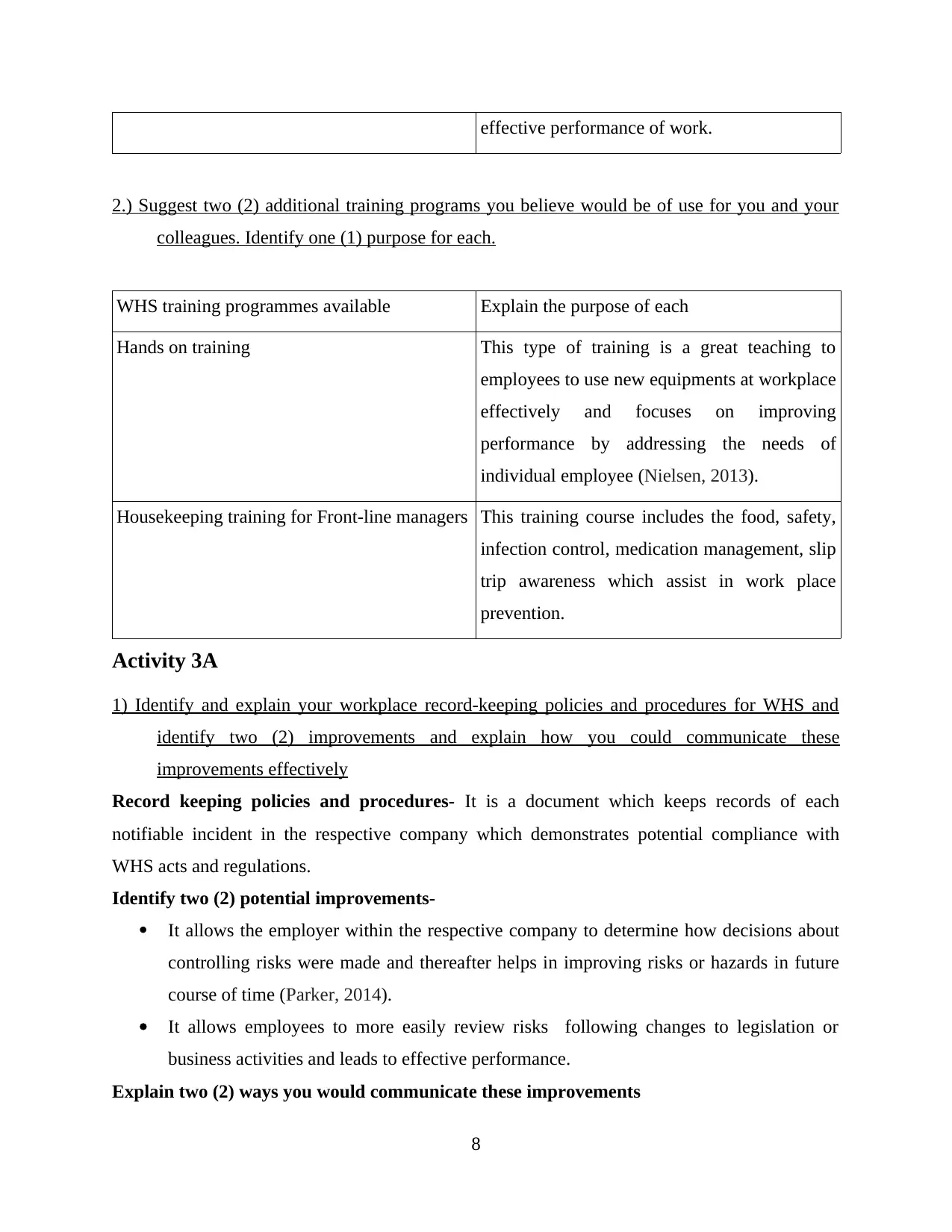
effective performance of work.
2.) Suggest two (2) additional training programs you believe would be of use for you and your
colleagues. Identify one (1) purpose for each.
WHS training programmes available Explain the purpose of each
Hands on training This type of training is a great teaching to
employees to use new equipments at workplace
effectively and focuses on improving
performance by addressing the needs of
individual employee (Nielsen, 2013).
Housekeeping training for Front-line managers This training course includes the food, safety,
infection control, medication management, slip
trip awareness which assist in work place
prevention.
Activity 3A
1) Identify and explain your workplace record-keeping policies and procedures for WHS and
identify two (2) improvements and explain how you could communicate these
improvements effectively
Record keeping policies and procedures- It is a document which keeps records of each
notifiable incident in the respective company which demonstrates potential compliance with
WHS acts and regulations.
Identify two (2) potential improvements-
It allows the employer within the respective company to determine how decisions about
controlling risks were made and thereafter helps in improving risks or hazards in future
course of time (Parker, 2014).
It allows employees to more easily review risks following changes to legislation or
business activities and leads to effective performance.
Explain two (2) ways you would communicate these improvements
8
2.) Suggest two (2) additional training programs you believe would be of use for you and your
colleagues. Identify one (1) purpose for each.
WHS training programmes available Explain the purpose of each
Hands on training This type of training is a great teaching to
employees to use new equipments at workplace
effectively and focuses on improving
performance by addressing the needs of
individual employee (Nielsen, 2013).
Housekeeping training for Front-line managers This training course includes the food, safety,
infection control, medication management, slip
trip awareness which assist in work place
prevention.
Activity 3A
1) Identify and explain your workplace record-keeping policies and procedures for WHS and
identify two (2) improvements and explain how you could communicate these
improvements effectively
Record keeping policies and procedures- It is a document which keeps records of each
notifiable incident in the respective company which demonstrates potential compliance with
WHS acts and regulations.
Identify two (2) potential improvements-
It allows the employer within the respective company to determine how decisions about
controlling risks were made and thereafter helps in improving risks or hazards in future
course of time (Parker, 2014).
It allows employees to more easily review risks following changes to legislation or
business activities and leads to effective performance.
Explain two (2) ways you would communicate these improvements
8
⊘ This is a preview!⊘
Do you want full access?
Subscribe today to unlock all pages.

Trusted by 1+ million students worldwide
1 out of 14
Related Documents
Your All-in-One AI-Powered Toolkit for Academic Success.
+13062052269
info@desklib.com
Available 24*7 on WhatsApp / Email
![[object Object]](/_next/static/media/star-bottom.7253800d.svg)
Unlock your academic potential
Copyright © 2020–2025 A2Z Services. All Rights Reserved. Developed and managed by ZUCOL.




